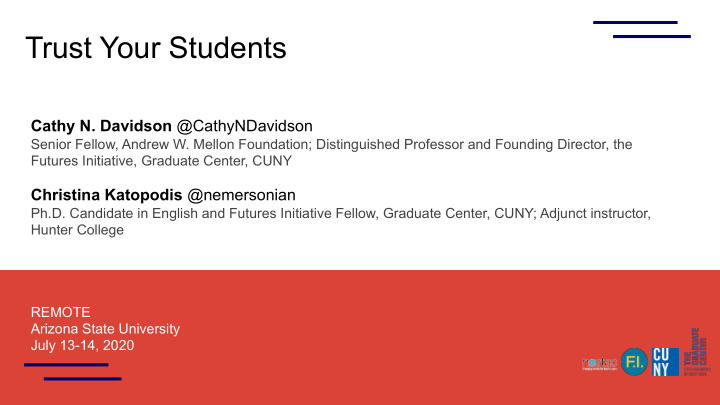



Trust Your Students Cathy N. Davidson @CathyNDavidson Senior Fellow, Andrew W. Mellon Foundation; Distinguished Professor and Founding Director, the Futures Initiative, Graduate Center, CUNY Christina Katopodis @nemersonian Ph.D. Candidate in English and Futures Initiative Fellow, Graduate Center, CUNY; Adjunct instructor, Hunter College REMOTE Arizona State University July 13-14, 2020
Images via Wikimedia Commons School, verb . From Farmers to Factory Workers
Nikolayhg on Pixabay Futures Initiative One-to-Many vs. Many-to-Many
Educational social networks like HASTAC.org (“HAYSTACK”)
Image via NYPost Our Students are not Homogeneous
“The Top 100%” ● 18 Million undergrads ● 40%+ Community College ● 40% Work > 30 hours a week ● 25% Full time school & work ● 25% Over 25 years old ● 30% First gen college students ● 24% Low income ● 25% Food and housing insecurity ● 58% Female ● 45% Students of color ● 0.4% at Ivies Dr. Gail Mellow, President Emerita LaGuardia Community College Gail Mellow, “The Biggest Misconception About Students Today,” NYT, August 28, 2017.
“Don’t you realize that every time you don’t answer a question, you’re learning something? You’re learning how to make do with what you got, and you’re learning how not to ask for a raise … you’re learning how to take it. That’s not good … So, from now on, whenever I ask a question, everybody’s got to put their hand up. I don’t care whether you know the answer or not. You have to put your hand up … [We] need to teach people they are important enough to say what they have to say.” Samuel Delany, Novelist, Educator, Polymath https://vimeo.com/243689485 The Polymath, or the Life and Opinions of Samuel R. Delany, Gentleman
Good education ... ● is informed by issues of equity and justice ● is interactive and engaging ● is challenging and effective ● involves practice ● includes an instructor who is visible and active, and who exhibits care, empathy and trust for all students — Dr. Laura Gibbs (@onlineCrsLady), University of Oklahoma “Physical proximity is not a precondition of good education” — Dr. Lee Skallerup Bessette (@readywriting) Georgetown University
Before we even think about a syllabus Text or videos or Zoom, think about what it means to be a student. Now. “Whether teaching algebraic geometry or sociology or literature or art or religion, we need to begin with the question: ‘what would I need if I were a student in this historic moment?’ A great place to start? Ask them! ” Cathy N. Davidson, “The Single Most Essential Requirement in Designing a Fall Online Course,” HASTAC , May 11, 2020, https://bit.ly/HASTAC-May11. Photo by Cathy N. Davidson, HASTAC.org
“Total Participation” “Techniques that solicit participation and higher-order thinking from all participants at the same time.” — American Psychological Association Examples: • Think-Pair-Share • Entry and Exit Tickets • Fishbowl • Collaborative Note-Taking
1. What one book from class would you want to take with you? 2. What, if anything, from your old life do you want to leave behind? 3. What do you appreciate that you would like to take with you? 4. What change, if any, would you like to see, and commit to bring about, on the other side? Dr. Farah Jasmine Griffin, Chair, Department of African American and African Diaspora Studies Columbia University Farah Jasmine Griffin, “Teaching African American Literature During COVID-19,” Boston Review , May 21, 2020
What is one thing you did (or will do) this year to build trust and/or a sense of community with your students during remote teaching? Jot down your idea in the chat section ● (90 secs). Read and write a response to other ● comments in the chat (90 secs). An A/Synchronous Activity
Thank You Cathy N. Davidson @CathyNDavidson Senior Fellow, Andrew W. Mellon Foundation; Distinguished Professor and Founding Director, the Futures Initiative, Graduate Center, CUNY Christina Katopodis @nemersonian Ph.D. Candidate in English and Futures Initiative Fellow, Graduate Center, CUNY; Adjunct instructor, Hunter College
Recommend
More recommend